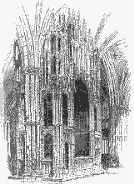English Medieval Architecture
Art in the Middle ages was inseparable from religion. It was infused with spiritual symbolism and meaning. The purpose of art was to awe and inspire the viewer with the grandeur of God. It also served to symbolize what people believed. Pope Gregory the Great, he of the Gregorian chants, said, "painting can do for the illiterate what writing does for those who read." He might have added that sculpture could serve the same purpose.
Church Sculpture
The mission of the sculptor, whose work was seen almost exclusively adorning church buildings, was to educate as well as decorate. He brought Biblical tales and moral lessons to life in stone. Carvings were not just religious, however. Everywhere you look there is evidence of pre-Christian symbology in church sculpture; animals real and fanciful, scenes of everyday life, and the pagan "Green man" peering out from amongst carefully wrought leaves and vines of stone. Sculpture burst forth gloriously in the Romanesque era, with little regard for classical conventions of proportion of figures.
Chapel of St. John at the
Tower of London,
a good example of
early Romanesque style
At the beginning of the Norman era the style of architecture that was in vogue was known as Romanesque, because it copied the pattern and proportion of the architecture of the Roman Empire. The chief characteristics of the Romanesque style were barrel vaults, round arches, thick piers, and few windows.
The easiest point to look for is the rounded arch, seen in door openings and windows. In general the Romanesque churches were heavy and solid, carrying about them an air of solemnity and gloom.
These early Norman churches were not always so stark as they seem today, however. In their heyday the church walls were hung with tapestries or painted richly. The statues of the saints were gilded (on some you can still see traces of the paint if you look closely), and the service books were inlaid with gold, jewels, and ivory. Chalices and reliquaries were encrusted with gems.

Gothic chantry chapel,
Winchester Cathedral
Beginning in 12th century France a new style of architecture and decoration emerged. At the time it was called simply "The French Style", but later Renaissance critics, appalled at the abandonment of classical line and proportion, derisively called it "Gothic". This was a reference to the imagined lack of culture of the barbarian tribes, including the Goths, which had ransacked Rome in the twilight of the Roman Empire.






